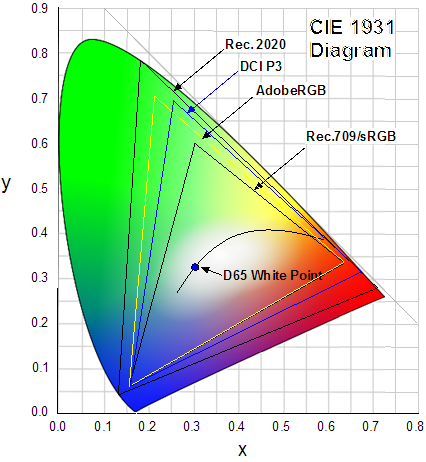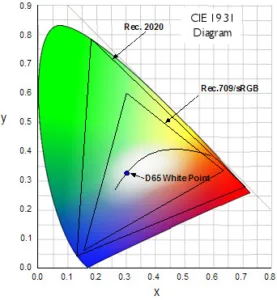I seem to have spent a lot of the last few weeks talking about, looking at and thinking about display colour. Although we have published a huge amount about high dynamic range (HDR), with good reason, the same increase in bit depth that will be introduced to support HDR is going to allow better colour reproduction as well as more punchy images.

Now, I’m no colour scientist, but I have come to appreciate the impact of better colour. It has long been one of the disappointments of the display world, that the colour standards that were used the move to digital TV and to HDTV were based on the capabilities of CRT displays. There was concern that the wider gamuts that might be possible with newer display technologies would look bad if displayed on CRTs, which were the de facto standard for professional and consumer displays when the standards were developed.
The HD standards were set up to use Rec. 709, which is the same as standard definition TV, and very similar to the sRGB system that was mandated for standard PC systems. That shared technology had the advantage of wide commonality between content creation systems and entertainment displays.
In looking at what the future could bring, the ITU made a new recommendation for wide colour gamut, the Rec 2020 recommendation. Rec 2020 has been adopted by NHK for its Super Hi-vision UltraHD TV system, which is due to appear in time for the Tokyo Olympics in 2020. The bigger gamut is significantly larger than the Rec. 709 gamut and we have featured a number of Display Daily articles that have talked about the issues in implementing the recommendation.
I’m not on the committee that made the recommendation, but like all real world standards, the final specification was influenced by a number of factors and there has been plenty of talk about the different points of view that led, finally, to Rec. 2020. One was a desire to cover most “real world colours”, including, but not limited to “Pointer’s Colours”. However, there were also other factors at play. For example, I’ve heard that there was a subset of the committee that simply wanted a wider gamut than was currently possible on the state of the art OLED/LCD display systems on the basis that there was plenty of time to improve on current technology, which was “bound to get better”.
Another factor was that green has proved a really problematic colour for laser makers and laser projectors were seen as an important way to deliver Rec. 2020 content (and having seen parts of Disney’s “Inside out” on a 6P laser projector, I can vouch for the impact that better colours can have). So the precise green of Rec. 2020 was set was partly set to accomodate the wishes of the laser projection community.
A further factor in pushing gamuts out was the desire of Quantum Dot makers (for an insight, see this DD from Chris QD Vision Discusses Developments and Competition) to push colour beyond established gamuts such as AdobeRGB and DCI P3 partly because the QD makers were already able to go wider gamuts, whereas other technologies, such as new phosphors in LED backlights, might struggle.
The resulting Rec 2020 standard, then, is a result of the compromises of a committee process, as most standards are. The major problem in the standard seems to be the difficulty in delivering volume products that can match the standard in the near term, as quantum dots with LED backlights cannot, currently, get to the primaries of the standard, even with revised colour filters. (see 3M to Propose Changes to New BT2020 Color Standard at SMPTE Fall Event)
It would be a shame if, like the original NTSC standard for colour, Rec 2020 was just aspirational for a long time. (there are also other issues – I have heard that the ICC profile system used to control colour on Windows and Mac computer systems is unable to encode Rec 2020 blue using 8 bit profiles, but I plan to come back to that point when I’ve got a better understanding of it*).
In the Meantime…
So, the question to me has been what do we do about wider colour gamuts while the challenges of delivering Rec 2020 get sorted out? There have been two items of news recently that I think might give a clue to this.

First, to nobody’s surprise, although the colour information will be encoded in a Rec 2020 format, movie content for the new UltraHD Blu-ray standard will be graded and created to match the DCI P3 colour gamut that has been used by Hollywood for digital cinema for several years. P3 is well understood, there are systems and hardware in place to use it well and it looks better than Rec. 709, so it has a lot of advantages.
 The second item of news seems to have slipped by a number of people. Recently, Apple announced two new iMacs that support DCI P3 as standard and that may be a significant change.
The second item of news seems to have slipped by a number of people. Recently, Apple announced two new iMacs that support DCI P3 as standard and that may be a significant change.
Display Daily’s friend, and image quality maven, Ray Soneira of DisplayMate, has pointed out in the past that Apple’s displays are extremely well adjusted and set-up, to the extent that some of their portable devices are accurate enough to be used in broadcast monitoring. He has speculated that Apple seemed to be doing a lot of work to bring all of its displays to a high level of consistency so that the colours always look the same, whether viewed on an iPhone, an iPad or an iMac. Wearing my marketeer’s hat, that seems to me a big advantage. So why would Apple abandon it by using P3 on iMacs?
Well, I’m speculating, as Apple is not in the habit of discussing this kind of topic in public, but I suspect that Apple wants to shift from using Rec 709 and sRGB to using P3. That would allow the company to react to the wider colour gamuts that, for example, Samsung can use on its OLED phones and tablets, but with a level of consistency that is in line with its previous products. Whether that means that they might have a marketing term such as “Movie colour” to match the “Retina display” term is not clear. Sometimes, Apple just does these things without making a lot of noise.
So, it seems to me that P3 could be an “intermediate” gamut that could deliver better colour and bring some order to the current disorder of “Wide colour gamut” displays for a number of years, until the issues in Rec. 2020 are resolved. – Bob Raikes
* If anybody does have a good understanding on this and can update me – I’m receptive!
For more on P3, see Matt’s previous DD, Three Steps to Better Color

